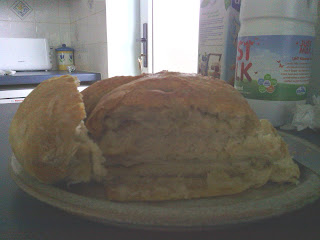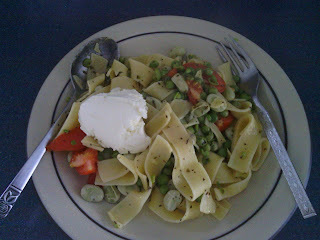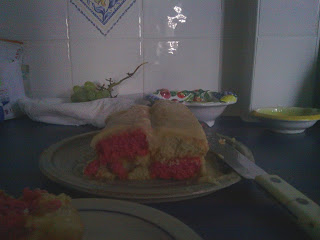I looked to the web to find some inspiration but found that most recipes involved taking a prepared baguette, stuffing it with garlic, chives and butter and then cooking it. For me this was all too easy and frankly pretty boring.
The soundtrack for the day's cooking was Elvis Costello and the Attractions' 1981 effort Trust an album which contains songs about working men's clubs, relationships and fish and chip paper and spans the genres of post punk, singer-songwriter, ska, soul pop, country, hard rock, rock and roll and rockabilly in a touch over half an hour.
I poured twelve ounces of white bread flour into a bowl with one sachet of yeast (available from most supermarkets) and an ounce of margarine. I mixed these together with a metal spoon until the margarine disappeared into the drier ingredients. Next I made a well in the middle of the bowl and poured in a beaten egg and a quarter of a pint of milk. I stirred them into the dry mixture until they made a soft dough.
At this stage the dough was too soft and sticky to knead properly so I added three tablespoonfuls of white bread flour into the bowl and kneaded the dough into the floor to make it lose its stickiness. Following this I punched the dough hard for about five minutes to remove any air pockets from it and left it on my window sill to rise for an hour.
In the meantime I made the filling. I cut up five cloves of garlic into the smallest pieces possible together with five heads of parsley. I then fried them on a low heat for five minutes in olive oil and then left them to cool.
 |
| Frying the garlic and parsley in olive oil. |
After the dough had risen I sprinkled some flour on the work surface and rolled the dough out until it was about a foot long and half a foot wide. I then spread the garlic and parsley evenly on top of the dough together with 100 grams of margarine.
The dough was then folded so the filling was covered and the dough resembled a square parcel. I brushed the top of the dough with milk and then cut some slits in the top to let the air out while it cooked.
I greased a high sided baking tray and put the dough into it. I cooked the dough in the oven for half an hour at 165 degrees (175 degrees if you have no fanned oven).
 |
| Freshly baked and ready to eat- in this case with homemade lasagne. |
When I removed the dough from the oven the smell of cooked garlic and melted margarine was the first thing I smelled. The bread itself had a soft inside which included just the right amount of garlic to give it taste but not so much that it was overwhelming. Through the cooking the 100 grams of margarine had sunk to the bottom of the bread and soaked into the base to make it crisp and very tasty.
 |
| Cross section of the bread with the melted margarine sunk to the bottom. |



